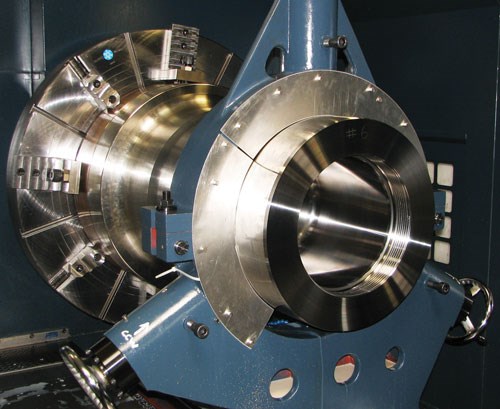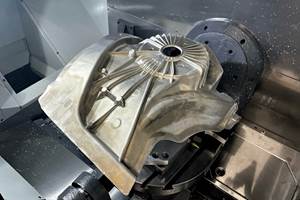Insert Provides Long Life, Short Cycle Times
Novatek, a manufacturer of diamond products used in the oil and gas, mining, construction and other industries, needed to reduce both costs and production time on a job involving very large workpieces. The Tiger-Tec black and gold WPP10 insert from Walter USA, which features an aluminum oxide coating designed to prolong tool life at high surface footages, helped the company increase feeds and speeds and create smaller, more manageable chips.
Share








Management at Novatek, a Provo, Utah-based manufacturer of industrial diamond products, believes harnessing technological solutions to improve productivity is important to stay afloat in today’s global market. Faced with insert life and chip control problems that increased costs and cycle times, they knew such a solution was needed for the company to keep its competitive edge. With aluminum-oxide, Tiger-Tec, black and gold coated inserts from cutting tool manufacturer Walter USA, the company was able to drive down costs on its diamond-sintering equipment while maintaining consistency in its turning operations.
Novatek was founded in 1985 as a developer of new technology involving high pressure/high temperature (HP/HT), wear-resistant materials and related applications. Today, the company manufactures diamond products serving the oil and gas, asphalt, mining and construction industries. The company’s presses clarify natural diamonds and sinter synthetic diamonds. Many of its products incorporate industrial polycrystalline diamond (PCD), which has been used in the drilling industry for decades.
Having pinpointed cutting tools as a particularly problematic and costly facet of Novatek’s business, Jay Reynolds, senior production plant engineer, researched several suppliers to find a solution that would increase insert life and improve chip control on rough and finish turning operations. Based on a recommendation from a local distributor, Novatek invited Walter USA’s Curt Nicholson to test that company’s products on a difficult application.
That application involves manufacturing six large cartridges for installation into a 400-ton diamond press. The cartridges are machined from 4340 FX-Xtra steel that is heat-treated to between 38 and 42 HRC. Two machines are used in the operation, a Johnford 60160G Super Turning Center and a Mori Seiki SL603CMC lathe. This is a big job—each cylinder weighs 12,500 pounds prior to any metal removal, for a total of 75,000 pounds of material in all six cylinders. Machining each cartridge to its final weight of 5,000 pounds requires removal of 7,500 pounds of steel, for a total of 30,000 pounds for all six parts.
To maximize performance, Mr. Nicholson suggested using Walter’s Tiger-Tec CNMG 644 NM9 WPP10 insert. Running at 0.22 ipr and 225 sfm at a cutting depth of 1/2 inch, the insert removed 450 pounds of steel per hour, outperforming both the previously used insert and competitor inserts tested at Novatek.
Machinist Ryan Reynolds says he was "amazed" by the performance of the Tiger-Tec WPP10 in this application. In addition to providing the capability to quickly hog out a lot of material, insert life was much greater with the WPP10 than with the competition. Two other inserts the company had tested lasted for 12 and 7 inches per cutting edge, respectively. In contrast, the Walter insert lasted for two 36-inch cuts—a total of 72 inches—down the part’s OD before requiring rotation to a new cutting edge. The difference is even greater than it appears at first glance—while the company tested the WPP10 in a dry cut, it ran the other two inserts with coolant. With coolant, the Tiger-Tec WPP10 lasted for 144 inches per cutting edge.
These figures show that compared with the insert that lasted for 12 inches, the WPP10 provides an 833-percent improvement in insert life without coolant and a 920-percent improvement with coolant. Moreover, the insert’s NM9 chipbreaker creates smaller, more manageable chips, saving time for operators who were used to frequently emptying large, stringy chips from the chip dumpster. "Our previous, longer chips created problems in our conveyor during the removal process," Mr. Reynolds says. "With Walter’s insert, our chips are now short and tight."
Walter’s technical knowledge also contributed to Novatek’s success. The cutting tool supplier provided recommendations on proper speeds and feeds as well as how to achieve the desired chip. With the new inserts, the company cut the time it spent roughing the parts from 16 hours to 9 hours. Total time savings amounted to 30 hours for each cartridge.
Mr. Nicholson says the insert’s performance is largely due to Walter’s aluminum oxide Tiger-Tec coating, which is designed to prolong tool life at high surface footages. "The aluminum oxide layer allows heat to be pulled away from the chip, which results in longer life and shorter cycle times," he explains. "This adds up to significant cost savings for the user."
Related Content
How to Mitigate Chatter to Boost Machining Rates
There are usually better solutions to chatter than just reducing the feed rate. Through vibration analysis, the chatter problem can be solved, enabling much higher metal removal rates, better quality and longer tool life.
Read MoreHow to Accelerate Robotic Deburring & Automated Material Removal
Pairing automation with air-driven motors that push cutting tool speeds up to 65,000 RPM with no duty cycle can dramatically improve throughput and improve finishing.
Read MoreToolpath Improves Chip Management for Swiss-Type Lathes
This simple change to a Swiss-type turning machine’s toolpath can dramatically improve its ability to manage chips.
Read MoreFixturing Castings Made Simple Through Adhesive Workholding
When a casting proved too malleable for traditional gripping, Thomas/Euclid Industries adopted — and succeeded with — Blue Photon adhesive workholding.
Read MoreRead Next
Building Out a Foundation for Student Machinists
Autodesk and Haas have teamed up to produce an introductory course for students that covers the basics of CAD, CAM and CNC while providing them with a portfolio part.
Read More5 Rules of Thumb for Buying CNC Machine Tools
Use these tips to carefully plan your machine tool purchases and to avoid regretting your decision later.
Read MoreRegistration Now Open for the Precision Machining Technology Show (PMTS) 2025
The precision machining industry’s premier event returns to Cleveland, OH, April 1-3.
Read More






















.png;maxWidth=150)












.jpg;maxWidth=300;quality=90)














